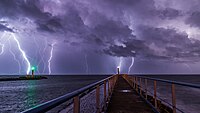
Photo from wikipedia
The understanding on the response of aluminum alloy to direct lightning currents is needed for lightning protection. Four typical lightning current components, which are the first return stroke current, subsequent… Click to show full abstract
The understanding on the response of aluminum alloy to direct lightning currents is needed for lightning protection. Four typical lightning current components, which are the first return stroke current, subsequent return stroke current, continuing current in the stroke intervals, and long continuing current, are simulated to investigate their damage effects on Al alloy 3003 material by laboratory experiments. The damage morphology on alloy’s surface and the microstructure in cross section are observed with high-resolution scanning electron microscope. Elemental composition changes of alloy material are measured by an X-ray energy dispersive spectrometer. Indentation hardness tests are conducted to measure the changes in alloy’s micro-hardness. Then, the damage characteristics and mechanisms of the alloy are analyzed by comparing the experimental results under different current parameters of lightning components. The results show that, in response to the first return stroke current component, a thin oxide layer and cracks are formed on the alloy’s surface. The cracks are initiated by the broken of the oxide layer. Under the continuing current component in the stroke intervals, the dendritic crystals appear and grow in the direction of temperature decrease inside the material. In response to the long continuing current component, uneven solidification induced cracks are formed. The over-burn phenomenon also occurs and lots of hydrogen evolution porosities appear. As a response to the subsequent return stroke current, the damage pattern on alloy’s surface is dominated by pits, and the thickness of the damaged layer is typically $15~\mu \text{m}$ .
Journal Title: IEEE Access
Year Published: 2018
Link to full text (if available)
Share on Social Media: Sign Up to like & get
recommendations!